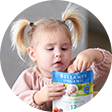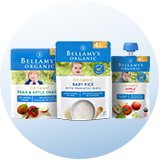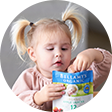Let’s talk about snacking: how often should kids snack?
Research shows toddlers and young children need to snack regularly to get all the calories and nutrients they need for optimal growth and development. The right types of snacks can be nutrient rich additions to the diets of small children as they grow and develop rapidly. Traditionally, a snack refers to something small – a piece of fruit, a piece of cheese or a biscuit or two – which offers a few carbohydrates and calories to keep your little one fuelled until their next meal. Unfortunately, in recent years the snacking landscape has changed significantly. It is not uncommon to see toddlers and small children munching on high sugar, processed snacks, multiple times each day. This is not exactly what is being suggested when professionals recommend that growing, healthy children eat frequently.
Snacking: what are the nutrients required?
Growing children need a range of specific nutrients including protein, fibre, iron, calcium and essential fats and 1,000 to 1,400 calories per day. Consider the size of a small child’s stomach is roughly the size of their fist and it is easy to see why three square meals will not get them all the calories and nutrients they require. This is why experts recommend young children include snacks as part of their usual daily intake. In terms of food, this translates to small children needing two to three small snacks each day – in addition to their regular meals and milk – which may contribute a significant number of calories depending on the age of the child.
Snacking: how much is too much?
What has been lost in translation is the scenario which sees young children eating constantly, grazing on a range of snack foods whenever desired. This poses an issue that children are taught to eat whatever they feel like depending on what snacks are on offer. In turn, this tends to see children who are not overly hungry for their meat and vegetables at dinnertime or their rather bland sandwich at lunch – as they have spent the morning snacking on sweet biscuits, fruit sticks, dried fruit and yoghurt. Now, no one is saying small children should not be left to starve! Rather they should have structure around their eating times so that they can learn there is a time to eat and a time to not – which is an important aspect of long-term appetite management. The question of how many snacks is individual to the child, however for most children it will translate to one or two morning snacks – dependent on the time of breakfast – and one afternoon snack followed by an early dinner. If dinner is served late, another late afternoon snack may be warranted. The key is to allow at least a couple of hours in between feeding occasions rather than encouraging all-day grazing. This will ensure small children experience hunger and eat because of it as opposed to eating simply because food is available.
Snacking: what are the best snacks for children?
An important thing to remember is that the sweeter foods we give children, the more they will want. Recent dietary data has shown between 25 and 30 percent of calories in the diets of Aussie toddlers was coming via extra foods such as biscuits, cakes, lollies and junk foods. This shows our young children are snacking on far too much processed sweet snack food at the expense of nutrient rich alternatives. The best snacks for children include nutrient rich options – fresh fruit, dairy, whole grains and home prepared foods like cheese, plain yoghurt, cut fruit or plain crackers with spread. You can imagine if a small child is used to being offered sweet biscuits, muesli bites, dried fruit sticks and straps, potato chips and baked goods that at first they may reject the less processed options. It is important to remember in this instance no child starves when food is available. Continue to offer them a couple of options every couple of hours. Eventually, if they are really hungry they will eat them. It is when we, as parents, give in and offer something more appealing in place of the apple or banana that young perceptive children learn they can decide what they will eat. Parents tend to loose control of the feeding environment and unfortunately their child’s nutritional platform.
































